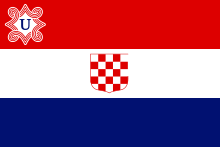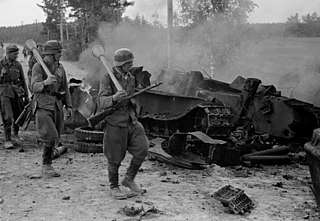Suomi KP/-31
| Suomi KP/-31 | |
|---|---|
.jpg) Suomi KP/-31 | |
| Type | Submachine gun |
| Place of origin | Finland |
| Service history | |
| In service | 1931–1998 Finland (in active service 1980s) |
| Used by | See Users |
| Wars |
Chaco War[1] Spanish Civil War[1] Winter War[2] World War II (or the Continuation War)[2] Lapland War[2] 1948 Arab–Israeli War[3] Korean War (Limited) |
| Production history | |
| Designer | Aimo Lahti |
| Designed | 1921 |
| Manufacturer | Tikkakoski |
| Produced | 1931–1953 |
| No. built | Approx. 80,000 |
| Variants | Kpist m/37, Kpist m/37-39, Kpist m/37-39F, Lettet-Forsøgs, Madsen-Suomi, Hispano Suiza MP43/44 |
| Specifications | |
| Weight | 4.6 kg (10.14 lb) |
| Length |
870 mm (34.3 in) 925 mm (36.4 in) (SJR) 740 mm (29.1 in) (bunker version) |
| Barrel length | 314 mm (12.4 in) |
|
| |
| Cartridge | 9×19mm Parabellum |
| Action | Straight Blowback |
| Rate of fire | 750–900 rounds/min |
| Muzzle velocity | 396 m/s (1,299 ft/s)[4] |
| Effective firing range | 200m[5] |
| Feed system | 20-, 36- or 50-round box, 40- or 71-round drum. Also modified German MP 38 u. 40 32-round box magazine |
| Sights | Front blade, rear notch |
The Suomi KP/-31 (Suomi-konepistooli or "Finland-submachine gun", literally: "Finland Machine-pistol") was a submachine gun (SMG) of Finnish design used during World War II. It was a descendant of the M-22 prototype and the KP/-26 production model, which was revealed to the public in 1925. The Suomi-konepistooli KP/-31 is often abbreviated to Suomi KP.
The Suomi KP/-31 is regarded by many[6] as one of the most successful submachine guns of World War II, also the soon developed 71-round drum magazine was later copied and adopted by the Soviets for their PPD-40 and PPSh-41 submachine guns.[7] The accuracy of the Suomi was superior to that of the mass-produced PPSh-41,[7] thanks in part to a noticeably longer barrel, with the same rate of fire and the equally large magazine capacity.[7] The major disadvantage of the Suomi KP/-31 was its high production cost.
The M-22 and KP/-26 were made by Konepistooli Oy, founded by Master Armorer Aimo Lahti, Captain V. Korpela, Lieutenant Y. Koskinen and Lieutenant L. Boyer-Spoof. The Suomi KP/-31 was designed by Koskinen and Lahti.
History
The Suomi KP/-31 went into serial production in 1931 by Tikkakoski Oy and most of these weapons were bought by the Finnish Defence Forces. The Finnish Defence Forces were equipped with about 4000 Suomi KP/-31 submachine guns when the Winter War started. During the course of the war, the design was altered with the addition of a muzzle brake, which increased the submachine gun's overall length by 55 mm. The revised version was designated KP/-31 SJR (suujarru, or "muzzle brake"). Aimo Lahti was displeased with this revision, believing that it decreased muzzle velocity and reduced the weapon's reliability, and even sought in vain to have the muzzle brake's designer court-martialed. Ultimately, roughly half of the KP/-31s in Finnish service were of the SJR version. Initially the KP/-31 was issued as a substitute for a light machine gun, and proved inadequate in this role. Instead, soldiers learned by trial and error how to use submachine guns to the best effect. By the time of the Continuation War, Finnish doctrine had been altered to include both a KP/-31 and a light machine gun (usually a captured Degtyaryov DP) in every infantry squad, and by 1943 this had been expanded to two KP/-31s per squad. KP/-31 production continued with the intention of adding a third submachine gun to each squad, but this plan was shelved in 1944 when the Continuation War ended.
The Suomi KP was also manufactured under licence in Sweden, Denmark, and Switzerland, where it was known as the Hispano-Suiza MP43/44.
Design
The Suomi KP/-31 also incorporated a few new design features, including an arrangement whereby the spring was mounted inside the bolt in order to make the gun shorter. Its 50-round quad-column "Casket" box magazine was more reliable than the early 40-round "bullets loaded nose down" drum magazine, and similar applications were used on the Argentinian C-4 submachine gun and present-day 60-round 5.45×39mm AK-74 compatible magazines.
Variants
A specialized bunker version was also produced in very small numbers (a total of 500 built) in 1941, the barrel shroud end of which was thinner and flattened to allow firing through the narrow ports of defensive bunkers.[8] This version had no shoulder stock and was equipped with a pistol grip. An even rarer version "900 kp 31 psv"[8] was produced for use as a secondary gun in the firing ports of Vickers Alt B Type E 6-Ton tanks, but only a few dozen were built before production was canceled due to the outbreak of the Winter War. Production never resumed, as captured Degtyaryov DP machine guns proved far superior in this role. Like the bunker version, the tank version had a pistol grip and no buttstock, and it could be quickly removed from the tank and fitted with a standard barrel shroud for infantry use if needed. The tank version remained in the Finnish Army's inventory through the 1980s, despite the tank it was designed for being retired in 1959.
In 2009, a semi-automatic version of the Suomi KP was produced for civilian sale in the United States,[9] replacing the receiver and lengthening barrel to meet the standards of the National Firearms Act.
Users



.svg.png)





.svg.png)



.svg.png)




Gallery
- KP/-31 with World War II-era magazines and cleaning kit.
- Bunker model KP/-31.
- KP/-31 with sectioned drum magazine.
 KP/-31 with drum magazine and ammunition package, below a sectioned example as well as a sectioned and normal drum magazine
KP/-31 with drum magazine and ammunition package, below a sectioned example as well as a sectioned and normal drum magazine- KP/-31 drum magazines, a sectioned example on the left.
 Swiss made Mp 43/44.
Swiss made Mp 43/44. Internal drawing of the Suomi SMG from the original patent.
Internal drawing of the Suomi SMG from the original patent. Finnish soldier armed with a Suomi KP and a Panzerfaust, walks past a destroyed Soviet tank.
Finnish soldier armed with a Suomi KP and a Panzerfaust, walks past a destroyed Soviet tank. A Finnish sub-machinegunner in the Vuosalmi bridgehead, Karelian Isthmus.
A Finnish sub-machinegunner in the Vuosalmi bridgehead, Karelian Isthmus.- Early 7.65 mm Suomi KP/-26.
See also
References
- Guns of the Third Reich, p. 163
- Thompson, Leroy (23 Mar 2017). The Suomi Submachine Gun. Weapon 54. Osprey Publishing. ISBN 9781472819642.
- 1 2 Thompson 2017, p. 6.
- 1 2 3 Thompson 2017, p. 4.
- 1 2 Thompson 2017, p. 5.
- ↑ "Gunwritersin Suomi-KP, osa 5". Guns.connect.fi. Retrieved 2011-12-06.
- ↑ "Suomi submachine gun (Finland)". Modern Firearms. Retrieved 12 February 2017.
- ↑ Combat Guns: An Illustrated Encyclopedia of 20th Century Firearms, Osprey, 1987 ISBN 9780600551782
- 1 2 3 Kekkonen, P. "Suomi Submachine Gun, KP/-31, part 2/2". Gunwriters. Retrieved 12 February 2017.
- 1 2 Kekkonen, P.T. (1999). "Mallit, variaatiot ja lisenssikopiot". Gunwriters (in Finnish). Retrieved 12 February 2017.
- ↑ "TNW Firearms, Inc. Manufacturers of the semi-auto 1919, M2HB and MG34". Tnwfirearms.com. Archived from the original on November 25, 2011. Retrieved 2011-12-06.
- 1 2 3 4 5 6 7 Thompson 2017, p. 69.
- 1 2 3 4 Thompson 2017, p. 70.
- ↑ Thompson 2017, p. 10.
- ↑ Bellec, Olivier (June 2000). "L'équipement et l'armement des corps francs". Militaria Magazine (in French). No. 179. Histoire & Collections. pp. 39–44.
- 1 2 Thompson 2017, p. 56.
- ↑ "Suomi m/1931". Encyclopédie des armes : Les forces armées du monde (in French). I. Atlas. 1986. p. 23.
- ↑
- ↑ Thompson 2017, pp. 68-69.
- ↑ "kpistar i Sverige". Gotavapen.se. Retrieved 2011-12-06.
External links
| Wikimedia Commons has media related to Suomi M31. |